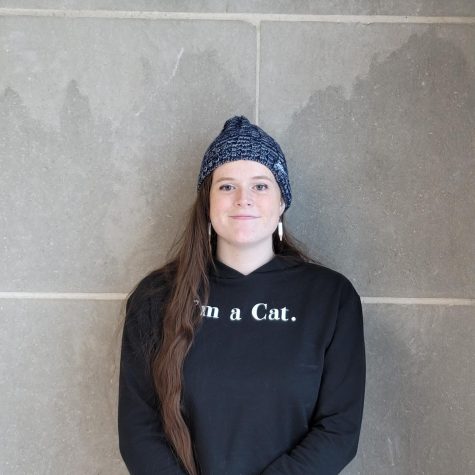Students now expected to have cameras on during instruction
March 2, 2021
Since the start of second semester, students have been required to keep their cameras on during online Zoom classes, a change from the expectations of first semester.
Initially, most teachers requested, but did not require cameras to be on at all times.
“The cameras-on policy was something we had always assumed was going to be a part of an online classroom,” said Jackie Thornton, Assistant Principal of Curriculum and Instruction. “But when we found out in August that Chromebooks aren’t compatible with virtual backgrounds, we were hesitant to start the school year with a policy about cameras on.”
Administrators wanted the transition back to school to be as easy as possible for students, and improperly functioning backgrounds could have caused unnecessary complexities. However, as the semester went on, teachers and administration saw more of a need for using cameras to boost a sense of classroom community and improve student participation in class.
Carrie McFadden, Assistant Principal for Operations, experienced these issues firsthand when she spent a day observing classes.
“Not a single person had their camera on throughout the entire class period,” McFadden said.
For some teachers, teaching to students they can’t see creates a lack of personal interaction that can make teaching more challenging.
“It’s hard for [teachers] to feel if [students] are ‘getting it’,” McFadden said.
Most teachers find it far easier to teach when students have cameras on due to the increase in interaction they have and the more personable feel.
“I like it for two reasons: one, we can understand that students are engaged in the class,” speech teacher Barry Baldwin said. “And two, I think it keeps them honest as well in terms of ‘okay my camera’s on, I need to pay attention. If my camera’s off, I can leave.’ I had a kid who left for 20 minutes to go make a sandwich.”
When school officials noticed many students’ grades trending downward during first semester, a potential lack of interest and engagement related to remote learning was targeted as a potential culprit, and asking students to turn on their cameras became one piece of the solution.
“The change was made in the best interest of students,” McFadden said.
The intention of the change was also to help teachers better communicate and relate to students.
“When you can see someone else’s facial expressions you can better empathize with them,” psychology teacher Cindy Tilt said.
Even before the new cameras-on requirement was implemented, many students chose to keep them on during class. Others said they decided to do so depending on the particular class, among other factors.
“It used to be optional, so I turned on my camera in classes that I liked, or when I felt good,” freshman Violet Whelchel said. “But now it’s required, and I feel like I have to look presentable all the time.”
Some students even noted feeling less cooperative as they felt like they were losing some of their choice. Others noted that the expectation can sometimes feel like a bit of a privacy invasion.
“If my parents or my brother walks in or is yelling, I don’t always want to have my camera on where everyone can see that,” said freshman Faiz Muhammed.
In typical in-person schooling, a student’s home remains private from the class and teacher, but Zoom gives peers a window into a student’s home life.
“Your home is a very personal space, and being forced to show it when you don’t want to is kind of an invasion of privacy,” Whelchel said.
Despite these concerns, the response to the change from teachers has been “overwhelmingly positive” according to Thornton. But there are teachers who align more closely with a student point of view.
“You would never want a teacher coming to your private home, and to me this is right on the line of invading a student’s privacy,” physics teacher Tom Sanoshy said.
Sanoshy acknowledges that it is common for students on Zoom to feel self-conscious, which can create a less cooperative environment if students are not comfortable. It doesn’t help, he said, that Zoom makes it difficult for users to avoid viewing their own images.
“Often I don’t even like looking at myself on Zoom,” Sanoshy said. “If you’re laying in bed, or if you’re self conscious, I can understand why you might not want to have it on.”
Despite the rule change, teachers still retain the option to make decisions about the status of camera uses in their own classrooms. Sanoshy has never required students to have their cameras on.
“I would request that [students] turn on their camera,” Sanoshy said. “But I would never make it a requirement.”
To address the issue of accounting for students who decide to leave their cameras turned off, Sanoshy asks students to send him a message to confirm they are present.
“If I ever did ask a student to turn on their camera, it’s in a breakout room,” Sanoshy said. “When they are interacting with each other it’s more important, but in class they’re just listening.”
Tilt explained that a phenomenon called the “spotlight effect” could play a role in some students’ hesitancy to turn their cameras on.
“They think everybody’s paying attention to them and everything they do,” Tilt said.
While most of the time this is not true, the spotlight effect can eat away at a student’s focus and cause distractions for some. One solution to this problem is for students to use a Zoom feature that allows users to turn off the view of themselves while keeping their camera on.
In the end, teachers like Sanoshy say they ultimately see little difference between teaching with a camera on or off.
“Teaching through Zoom, even when you can see the students, is still a really challenging experience,” Sanoshy said. “You don’t hear much from them anyway. Whether I am teaching a moving picture of them or a blank screen doesn’t make much of a difference.”
For their part, many students continue to navigate different requirements from different teachers, which causes some to feel like a school-wide mandate doesn’t even exist.
“[In] some classes the teacher is telling us to keep our cameras on the entire period and other classes they just don’t care at all,” freshman Jonathan Zhang said.
Many teachers, like Tilt, see student visibility via engaged cameras as a kind of accountability. But there are students who question whether any policy can have much control over engagement and accountability in an online learning environment.
“Some students were not paying attention and even failing classes, so I understand why [they require our cameras to be on],” Freshmen Ziad Elbago But that’s not every student, so not every student needs to be treated the same.”
Other students went so far as to say they believe the rule makes little to no difference one way or another.
“My camera is always on and I’m never engaged,” freshman Eli Zegarski said. ”It doesn’t really change anything.”
Students are finding that their ability to remain engaged in learning remains a personal choice, whether they are attending school in person or online.
“It doesn’t really matter if their camera is on or off,” sophomore Ryan Zhao said. “If someone really cares they’ll be engaged, but if they don’t want to be you can’t make them.”
So what happens when a teacher does require students to attend online classes with their cameras turned on and they refuse to cooperate? Suggested repercussions include emails to parents or a meeting with a dean to discuss the issue. But some teachers have instituted their own consequences.
“[One of my teachers] said they would mark us absent if we did not turn on our cameras,” Zhao said.
Despite the overall student opinion seeming unhappy, no significant response has been seen from students or parents.
“I know it’s lose lose-lose,” Baldwin said. “Lose for the parents, lose for the students and lose for the teachers. That’s unfortunate, but the nice part is, it’s like we’re all on the Titanic together.”









